-
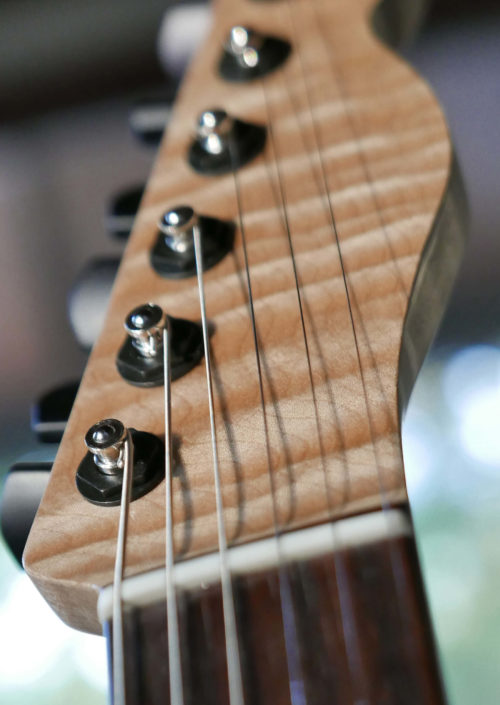 Another original, new, beautiful Custom Tele from master luthier Tony Nobles, based in Wimberly Texas. (Tony has crafted custom guitars for artists ranging in style from Joe Walsh to Alejandro Escovedo.) This guitar was custom made to our specs. And it’s one of one– the only one made with these features. Body: Figured Walnut top over adler Custom high end Musikraft quilted maple neck Width at the Nut: 1-11/16" Width at the Heel: 2-3/16 (55.56mm) Number of Frets: 21 Fret Type: Medium 6105 Finger Board Radius: 10" Body: natural, nitro lacquer finish Back of neck: natural, no finish Front of headstock: natural, nitro lacquer finish Bridge: Hannes by Schaller Non-Tremolo Bridge, #GTH RU-BLACK RUTHENIUM Tuners: Sperzel Trimlok Locking Guitar Tuners 6-in-line Trim-Lok Black Pickups: Harmonic Design "Vintage Plus" bridge and neck pickups
Another original, new, beautiful Custom Tele from master luthier Tony Nobles, based in Wimberly Texas. (Tony has crafted custom guitars for artists ranging in style from Joe Walsh to Alejandro Escovedo.) This guitar was custom made to our specs. And it’s one of one– the only one made with these features. Body: Figured Walnut top over adler Custom high end Musikraft quilted maple neck Width at the Nut: 1-11/16" Width at the Heel: 2-3/16 (55.56mm) Number of Frets: 21 Fret Type: Medium 6105 Finger Board Radius: 10" Body: natural, nitro lacquer finish Back of neck: natural, no finish Front of headstock: natural, nitro lacquer finish Bridge: Hannes by Schaller Non-Tremolo Bridge, #GTH RU-BLACK RUTHENIUM Tuners: Sperzel Trimlok Locking Guitar Tuners 6-in-line Trim-Lok Black Pickups: Harmonic Design "Vintage Plus" bridge and neck pickups -
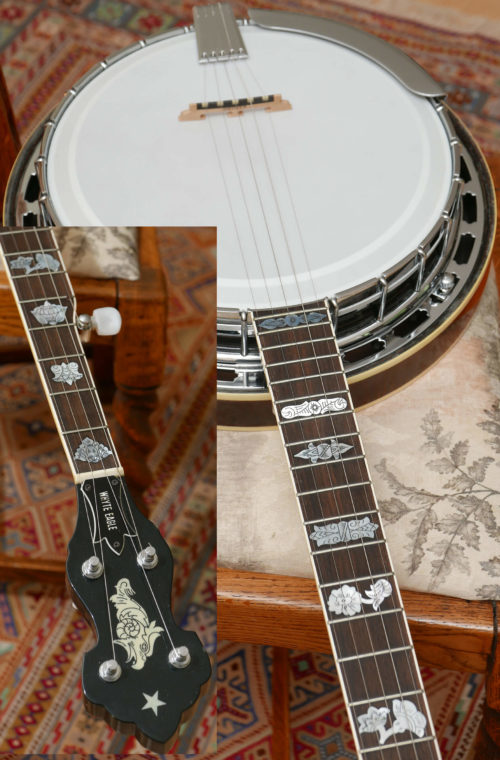 Early 1970s, but in remarkably original condition. And this instrument is from the first, early production– so it has the maple 3-ply rim. This should not be compared to later production Whyte Eagles– this is a very rare early one with unique features, and great tone. This banjo design is based on: • neck/head/inlays: based on the high end Fairbanks Whyte Ladye of the early 20th century– one of the most beautiful designs in banjo history • the pot assembly is modeled closely on the Gibson TB3, archtop of the 1930's. In fact it's a remarkable recreation of that design (and sound) – a more faithful recreation that many Gibson post-war versions. Bluegrass banjo players seek out the 70’s Alvarez Whyte Eagles, known for their tone and craftsmanship. It was a pretty short window of only about five years, when these banjos were made with this kind of craftsmanship. They blow away most any banjo made and marketed (from any country) in the 60s, 70s and 80s– and they show no logos on headstock– just beautiful mother of pearl. It’s the No. 4310 “Whyte Eagle”. Based on late 1920’s Vega Griffin (Tubaphone #9) style inlays, with engraved, carved heel. Sunburst finish maple banjo, Gibson-style 2 piece flange, full height 20 hole archtop tone ring, dual coordinator rods, flamed maple resonator, maple neck, chrome finish. Neck is butterfly with ebony strip on back of neck, down the center. It’s extremely rare to find a Whyte Eagle from this very early period (serial number 1672), when they first came out and the company bent over backwards to produce an instrument with zero compromise, from the inlays to the maple rim. The early features that are not on the later 70's Whyte Eagles, are– in addition to the 3-ply maple rim (not the 10-ply rim of almost all other Whyte Eagles)– the smaller star on the front of headstock (later models had a larger star), no “Alvarez” logo just the eagle inlay, and a darker sunburst on the resonator and also on the back of the neck. Flamed maple resonator (sunburst back, with a touch of milkiness to the original finish) Maple butterfly neck Hand-carved heel Mother of pearl inlays Original tuners Grover bridge 1 3/16 nut Scale: 26 ¼ inches 20 hole archtop tone ring 11 inch head ... no longer available ...
Early 1970s, but in remarkably original condition. And this instrument is from the first, early production– so it has the maple 3-ply rim. This should not be compared to later production Whyte Eagles– this is a very rare early one with unique features, and great tone. This banjo design is based on: • neck/head/inlays: based on the high end Fairbanks Whyte Ladye of the early 20th century– one of the most beautiful designs in banjo history • the pot assembly is modeled closely on the Gibson TB3, archtop of the 1930's. In fact it's a remarkable recreation of that design (and sound) – a more faithful recreation that many Gibson post-war versions. Bluegrass banjo players seek out the 70’s Alvarez Whyte Eagles, known for their tone and craftsmanship. It was a pretty short window of only about five years, when these banjos were made with this kind of craftsmanship. They blow away most any banjo made and marketed (from any country) in the 60s, 70s and 80s– and they show no logos on headstock– just beautiful mother of pearl. It’s the No. 4310 “Whyte Eagle”. Based on late 1920’s Vega Griffin (Tubaphone #9) style inlays, with engraved, carved heel. Sunburst finish maple banjo, Gibson-style 2 piece flange, full height 20 hole archtop tone ring, dual coordinator rods, flamed maple resonator, maple neck, chrome finish. Neck is butterfly with ebony strip on back of neck, down the center. It’s extremely rare to find a Whyte Eagle from this very early period (serial number 1672), when they first came out and the company bent over backwards to produce an instrument with zero compromise, from the inlays to the maple rim. The early features that are not on the later 70's Whyte Eagles, are– in addition to the 3-ply maple rim (not the 10-ply rim of almost all other Whyte Eagles)– the smaller star on the front of headstock (later models had a larger star), no “Alvarez” logo just the eagle inlay, and a darker sunburst on the resonator and also on the back of the neck. Flamed maple resonator (sunburst back, with a touch of milkiness to the original finish) Maple butterfly neck Hand-carved heel Mother of pearl inlays Original tuners Grover bridge 1 3/16 nut Scale: 26 ¼ inches 20 hole archtop tone ring 11 inch head ... no longer available ... -
Out of stock
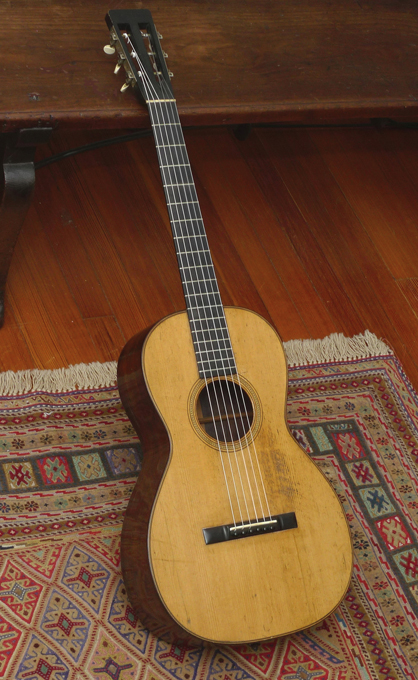 1855-1860 Martin “transitional”1-21. A very rare and exquisite large size Martin from the pre-1867 era. “Large size” Martin from the 1850’s, because the Size 1, and 0, were the only “large” size Martins in those years. And there is currently not a single other size 1 or 0 size pre-1867 Martin guitar on the market. This is considered by the top U.S. experts who vetted this instrument as an early, rare "transitional" 1-21, based on the fact that it does not have all the later, standardized, 1860’s and on “21” attributes– specifically, backstrip and endwedge on this instrument are not typical of “price-list” era 21’s (after the publishing of the first Martin price lists, establishing features of the different models, in the 1860’s) This 1-21 has:
1855-1860 Martin “transitional”1-21. A very rare and exquisite large size Martin from the pre-1867 era. “Large size” Martin from the 1850’s, because the Size 1, and 0, were the only “large” size Martins in those years. And there is currently not a single other size 1 or 0 size pre-1867 Martin guitar on the market. This is considered by the top U.S. experts who vetted this instrument as an early, rare "transitional" 1-21, based on the fact that it does not have all the later, standardized, 1860’s and on “21” attributes– specifically, backstrip and endwedge on this instrument are not typical of “price-list” era 21’s (after the publishing of the first Martin price lists, establishing features of the different models, in the 1860’s) This 1-21 has:- Diamond marquetry backstrip (not found on later, 1860’s 1-21s)
- Marquetry endwedge (not found on later, 1860’s 1-21s) (Wood end wedge and herringbone backstrip were the standard features of the 1860’s and after 1-21’s)
- X-braced. All braces are 100% original. No internal repairs to braces.
- Slot head
- Ebonized neck (maple neck, ebonized, i.e. painted black). This is another transitional feature: black neck was replaced by cedar on Style 21 by the time the Martin price list was first printed.
- Single "tone bar" brace behind the bridge plate
- Ice cream cone-shaped heel (1860’s 1-21’s had cedar neck, with Spanish style heel not ice cream cone heel)
- Three "CF Martin New-York" stamps: one inside center strip; the second on neck block (this stamp is upside down, as it should be); the third on back of guitar (near heel), the third stamp transversing the backstrip on the back of the guitar near the heel.
- Solid Brazilian Rosewood back and sides
- All original finish, everywhere; no touch-ups, overspray, etc, of any kind ever done
- Brazilian rosewood back shows beautiful sawmarks
- Bridge, more than a century old, is probably a replacement bridge… but on the original bridge footprint
- Original ivory nut
- Original bridge plate (mahogany)
- No back cracks, or side cracks; one top crack, repaired
- Tuners are modern replacements, vintage style, in original slot holes
- Original frets
-
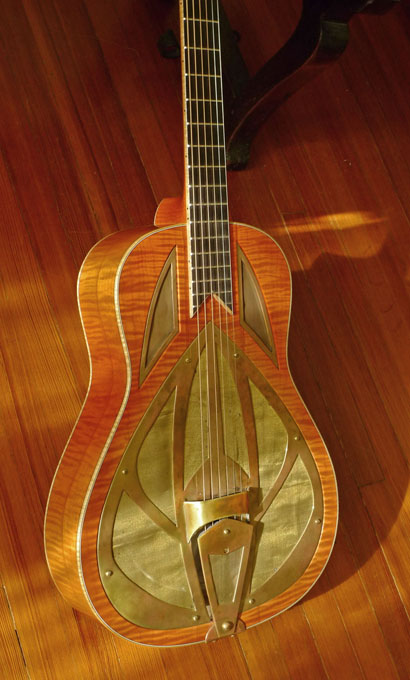 This stunningly beautiful, one-of-a-kind custom built resonator (from 2006, in beautiful crack-free condition and with only light wear) is from Tony Nobles, well-known luthier, and maker of instruments for Joe Walsh, Billy Gibbons and many other artists. The art deco ornamentation compliments an incredibly well built instrument, with meticulous attention to detail. Listen to/watch the video clip where guitar master Redd Volkaert put this instrument through some interesting jazz and blues paces.
This stunningly beautiful, one-of-a-kind custom built resonator (from 2006, in beautiful crack-free condition and with only light wear) is from Tony Nobles, well-known luthier, and maker of instruments for Joe Walsh, Billy Gibbons and many other artists. The art deco ornamentation compliments an incredibly well built instrument, with meticulous attention to detail. Listen to/watch the video clip where guitar master Redd Volkaert put this instrument through some interesting jazz and blues paces.- Spun-aluminum Quartermane biscuit-style cone (single-cone resonator)
- Solid curly maple, back top, and sides, with light tobaccoburst nitrocellulose lacquer finish
- Art deco coverplate, soundholes, and tailpiece of antiqued brass with a metal mesh covering
- Maple binding on body
- Custom torch inlay on headstock
- Curly maple neck
- Waverly tuners
- Scale: 24.4 inches
- Nut width: 1 7/8 inch
- String spacing at nut: 1 18/32
- Bridge spacing: 2 1/8
- Lower Bout: 14 1/2
- Upper bout: 9 1/2
- Body depth at bottom: 3 ¾ inches
- Body depth at neck joint: 3-20/32
-
 When this concert guitar was made in 1976, it was the top model offered by the master luthier Masaru Kohno– when he was at the very height of his career. There is some confusion out there as to which Kohno was the “top” concert model at any given date in height of Masaru Kohno’s career– from the early 70’s to the late-80s’. No confusion here– as there is correspondence (from August 2011) directly from Masaki Sakurai to us, regarding this guitar. Masaki Sakurai (nephew of Masaru Kohno, who in fact worked along side Masaru Kohno when this instrument was made in 1976, and now of course runs the “Sakurai/Kohno” shop, since the death of Masaru Kohno in 1998) confirms that this guitar was the top model available from Kohno in mid-1976. (Don’t be confused– a later, for example 1980 No. 30 Kohno is not a top Kohno model from that year. By 1980, the top model was a No. 50.) The confusion arises because Kohno had, in the early 70s until the late 80’s the custom of making his model numbers correspond to the guitars’ price in Japanese Yen. Hence, this guitar, a “No. 30”, in mid-1976, was priced at 300,000 Japanese Yen, and was the top model (a very expensive guitar in 1976). The confusion arises because as the inflation-prone 70’s continued, everyone adjusted prices upward. When inflation kept advancing, Kohno model numbers were something of a moving target, and the “top model” number changed upwards over time. Over time the top model moved up to No. 30 (this guitar), and then later No. 50 (starting in 1977). Kohno finally stopped using numbers in the 80’s and then called the top model the “Professional J”, and on, with more variations of “Professional”.) In any case this guitar, was the top model made, when it came from the Kohno shop (correspondence from Masaki Sakurai confirming this, will be supplied). But the real proof is in the playing. This instrument stands along with the best brazilian rosewood/spruce concert guitars from any maker, anywhere, any period. Crystal clear brazilian trebles. Wonderful resonance, combined with superior string separation.
When this concert guitar was made in 1976, it was the top model offered by the master luthier Masaru Kohno– when he was at the very height of his career. There is some confusion out there as to which Kohno was the “top” concert model at any given date in height of Masaru Kohno’s career– from the early 70’s to the late-80s’. No confusion here– as there is correspondence (from August 2011) directly from Masaki Sakurai to us, regarding this guitar. Masaki Sakurai (nephew of Masaru Kohno, who in fact worked along side Masaru Kohno when this instrument was made in 1976, and now of course runs the “Sakurai/Kohno” shop, since the death of Masaru Kohno in 1998) confirms that this guitar was the top model available from Kohno in mid-1976. (Don’t be confused– a later, for example 1980 No. 30 Kohno is not a top Kohno model from that year. By 1980, the top model was a No. 50.) The confusion arises because Kohno had, in the early 70s until the late 80’s the custom of making his model numbers correspond to the guitars’ price in Japanese Yen. Hence, this guitar, a “No. 30”, in mid-1976, was priced at 300,000 Japanese Yen, and was the top model (a very expensive guitar in 1976). The confusion arises because as the inflation-prone 70’s continued, everyone adjusted prices upward. When inflation kept advancing, Kohno model numbers were something of a moving target, and the “top model” number changed upwards over time. Over time the top model moved up to No. 30 (this guitar), and then later No. 50 (starting in 1977). Kohno finally stopped using numbers in the 80’s and then called the top model the “Professional J”, and on, with more variations of “Professional”.) In any case this guitar, was the top model made, when it came from the Kohno shop (correspondence from Masaki Sakurai confirming this, will be supplied). But the real proof is in the playing. This instrument stands along with the best brazilian rosewood/spruce concert guitars from any maker, anywhere, any period. Crystal clear brazilian trebles. Wonderful resonance, combined with superior string separation.- Hand-signed on label by Masaru Kohno, and dated 1976
- Solid European spruce top
- Solid Brazilian rosewood back and sides
- 660mm scale length
- Nut: 52mm
- Mahogany neck with 2 ebony supporting strips
- Ebony fretboard
- Gold engraved Gotoh tuners
- One repaired crack on back of guitar
- Crack-free top and sides. There are various nicks, dings, and scratches.
- Finish is naturally worn off, through playing, on the center section of the back of the neck– giving it a very fast feel in the left hand.
-
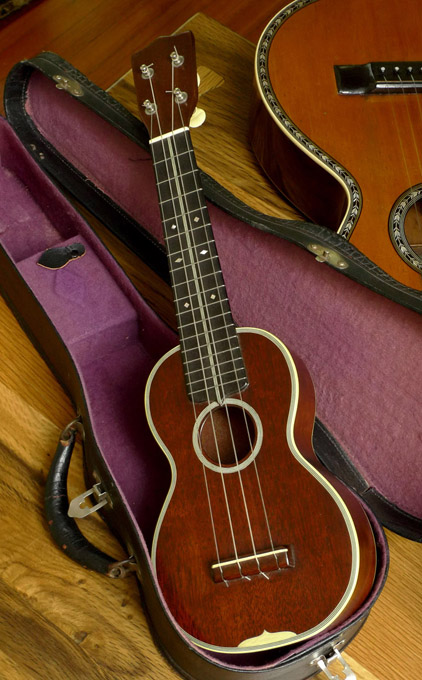 In the 1920’s and early 30's, the Hawaiian craze was in full bloom, and ukulele production was crucial to Martin’s success in this period. This is a wonderful, extremely well-preserved example of one of the most ornate of the Martin ukuleles, still in its original Geib case. Although Martin ukes built after 1916 carried no serial number, it’s possible to generally date them by stylistic elements. This Martin Style 3 is from the best era, the golden era, from about 1925 to 1930. Martin style 3 was first made in 1918. Martin Style 3, soprano (standard) specs:
In the 1920’s and early 30's, the Hawaiian craze was in full bloom, and ukulele production was crucial to Martin’s success in this period. This is a wonderful, extremely well-preserved example of one of the most ornate of the Martin ukuleles, still in its original Geib case. Although Martin ukes built after 1916 carried no serial number, it’s possible to generally date them by stylistic elements. This Martin Style 3 is from the best era, the golden era, from about 1925 to 1930. Martin style 3 was first made in 1918. Martin Style 3, soprano (standard) specs:- Mahogany body
- 7 layer top binding
- 3 layer back binding
- Ebony fretboard
- 5 layer soundhole ring
- Celluloid ornament on top, behind bridge (known as the "parend", or “shield”)
- Bar frets
- Small pearl paired-diamond inlays at fret 5, 7, and 9
- Three lines inlaid down center of fingerboard
- Nickel plated pegs (introduced in 1923)
- CF Martin & Co, stamped on back of peghead, and inside-back (Martin logo was not put on front of peghead until 1932)
-
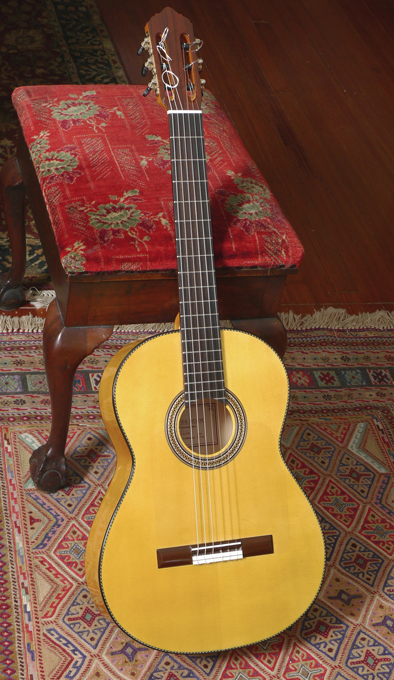 Brand new, Lester Devoe Flamenco Blanca, custom made (details on request). Lester Devoe needs no introduction to the world’s top flamenco players. His reputation was established decades ago (and his new models are the best ever made, and in huge demand worldwide). His guitars are played by the world’s top performing and recording flamenco artists. This instrument, custom made with a unique Spanish Cypress to add a more robust treble response to the legendary deep, throaty, percussive bass response of the Devoe Blanca, will amaze.
Brand new, Lester Devoe Flamenco Blanca, custom made (details on request). Lester Devoe needs no introduction to the world’s top flamenco players. His reputation was established decades ago (and his new models are the best ever made, and in huge demand worldwide). His guitars are played by the world’s top performing and recording flamenco artists. This instrument, custom made with a unique Spanish Cypress to add a more robust treble response to the legendary deep, throaty, percussive bass response of the Devoe Blanca, will amaze.- Flamenco Blanca
- 650mm scale length
- Spanish cypress back and sides (custom, details on request)
- European spruce top
- Ebony fingerboard
- Sloane tuners
- Rosewood headstock veneer
- Cedar neck
- Nitrocellulose lacquer finish
-
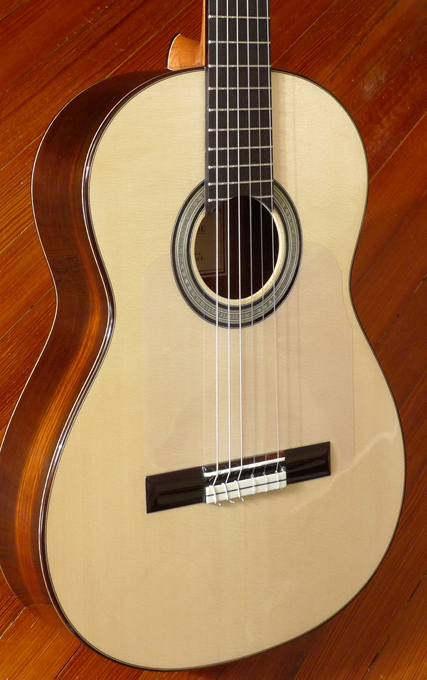 This new, custom made Lester Devoe Flamenco Negra is amasterpiece, from one of the world’s top luthiers. Lester Devoe needs nointroduction to the world’s great Flamenco players. The late, legendary Sabicasplayed a Devoe– and converted some of the great Flamenco players in Spain tothe fold. Paco De Lucia, and Vicente Amigo, among others, play Devoe Flamencoguitars. Paco De Lucia began playing a Devoe Negra guitar years ago– and thereare many Paco De Lucia recordings and feature films where Paco plays a DevoeFlamenco guitar.) This is the second custom guitar, that Lester has made for uswith select, old growth, quartersawn AAAAA Brazilian rosewood. Signed by LesterDevoe, 2012 (March).
This new, custom made Lester Devoe Flamenco Negra is amasterpiece, from one of the world’s top luthiers. Lester Devoe needs nointroduction to the world’s great Flamenco players. The late, legendary Sabicasplayed a Devoe– and converted some of the great Flamenco players in Spain tothe fold. Paco De Lucia, and Vicente Amigo, among others, play Devoe Flamencoguitars. Paco De Lucia began playing a Devoe Negra guitar years ago– and thereare many Paco De Lucia recordings and feature films where Paco plays a DevoeFlamenco guitar.) This is the second custom guitar, that Lester has made for uswith select, old growth, quartersawn AAAAA Brazilian rosewood. Signed by LesterDevoe, 2012 (March).- 650mm scale length
- Nut: 52mm
- Neck width at nut: 52mm
- 80 year old Brazilian Rosewood (pre-CITES) back and sides (Quartersawn).
- European spruce top
- Cedar neck
- Brazilian Rosewood headstock overlay, and bridge
- Brazilian Rosewood body binding, top and back
- Ebony fingerboard
- Sloane tuners
- Nitrocellulose lacquer finish
-
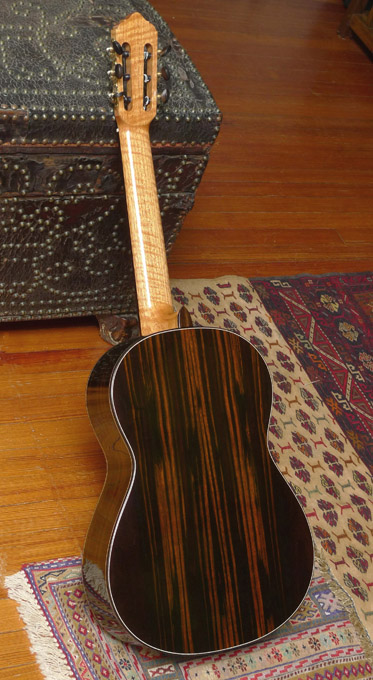 Vustom made Lester Devoe Flamenco Negra, a one-of-a-kind, Brazilian Rosewood guitar, from one of the world’s top luthiers. Lester Devoe needs no introduction to the world’s great Flamenco players. The late, legendary Sabicas played a Devoe– and converted some of the great Flamenco players in Spain to the fold. Paco De Lucia, and Vicente Amigo, among others, play Devoe Flamenco guitars. (I personally delivered a Devoe Flamenco Blanca guitar to Paco De Lucia in Spain in late 2010– Paco likes his Devoe’s hand-delivered. Paco De Lucia began playing a Devoe Negra guitar years ago– and there are many Paco De Lucia recordings and feature films where Paco plays a Devoe Flamenco guitar.) And it’s rare that Lester makes a Negra with Brazilian rosewood of this age and quality.
Vustom made Lester Devoe Flamenco Negra, a one-of-a-kind, Brazilian Rosewood guitar, from one of the world’s top luthiers. Lester Devoe needs no introduction to the world’s great Flamenco players. The late, legendary Sabicas played a Devoe– and converted some of the great Flamenco players in Spain to the fold. Paco De Lucia, and Vicente Amigo, among others, play Devoe Flamenco guitars. (I personally delivered a Devoe Flamenco Blanca guitar to Paco De Lucia in Spain in late 2010– Paco likes his Devoe’s hand-delivered. Paco De Lucia began playing a Devoe Negra guitar years ago– and there are many Paco De Lucia recordings and feature films where Paco plays a Devoe Flamenco guitar.) And it’s rare that Lester makes a Negra with Brazilian rosewood of this age and quality.- 650mm scale length
- Nut: 52mm
- Neck width at nut: 52mm
- String Spacing at nut: 44mm
- 80 year old Brazilian Rosewood (pre-CITES) back and sides (Quartersawn).
- European spruce top, with some beautiful and understated “"hazelfichte" (what Americans call bear claw).
- Custom, flamed Spanish Cedar neck
- Brazilian Rosewood headstock overlay, and bridge
- Brazilian Rosewood body binding, top and back
- Ebony fingerboard
- Sloane tuners
- Austere yet elegant Santos style black and white rosette, that Devoe uses only rarely, on top custom models
- Nitrocellulose lacquer finish
-
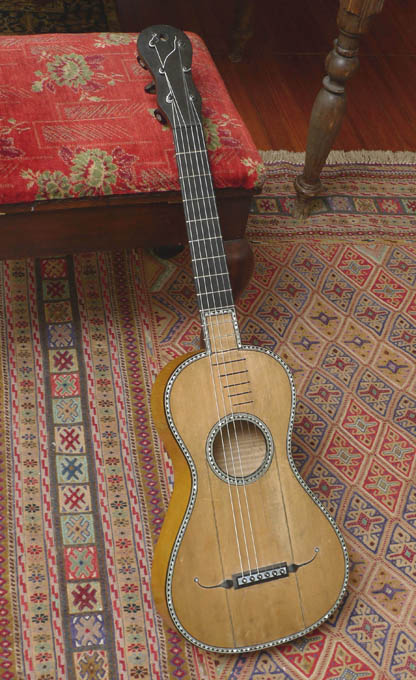 This fine and early example of the French guitar was made in Mirecourt, France, around 1800 to 1810. And sold through the famous Parisian dealer Koliker. It is a rare early example, as indicated by its rectangular bridge that does not have a separate saddle, but uses the top edge of the ebony rectangle as the saddle (this feature places it circa 1800, not like the more common 1820-1840 French guitars that have a more modern style bridge including a regular saddle). But for all its rarity, and exoticism to modern eyes, the most salient feature of this guitar is that it plays wonderfully. This is no museum piece to hang on a wall or shelf. This guitar is to play and enjoy. It plays beautifully, with all frets in tune. With no buzzing... I have had guitars from the 1960’s that do not play as well, in tune, and sound as well as this one. Even the action is perfect. The guitar has a wonderful tone, with a sweetness and brightness from the maple, and full bass response.
This fine and early example of the French guitar was made in Mirecourt, France, around 1800 to 1810. And sold through the famous Parisian dealer Koliker. It is a rare early example, as indicated by its rectangular bridge that does not have a separate saddle, but uses the top edge of the ebony rectangle as the saddle (this feature places it circa 1800, not like the more common 1820-1840 French guitars that have a more modern style bridge including a regular saddle). But for all its rarity, and exoticism to modern eyes, the most salient feature of this guitar is that it plays wonderfully. This is no museum piece to hang on a wall or shelf. This guitar is to play and enjoy. It plays beautifully, with all frets in tune. With no buzzing... I have had guitars from the 1960’s that do not play as well, in tune, and sound as well as this one. Even the action is perfect. The guitar has a wonderful tone, with a sweetness and brightness from the maple, and full bass response.- All original finish on the guitar
- Flamed solid Maple back and sides
- Spruce top, with no finish on the spruce… this is a characteristic of guitars from this time and place. While the back and sides of the guitar were French polished, the spruce top was left as natural wood, with no finish.
- One of the friction pegs is a modern replacement
- The two dark splices on the soundboard are later, but still 19th century, restorations, done as decorative flourishes.
- Scale length: 64.3 cm
- Length of body: 43.3 cm
- Koliker, Luthier Rue Croix-des-Petits Champs No. 24 A. Paris
-
Out of stock
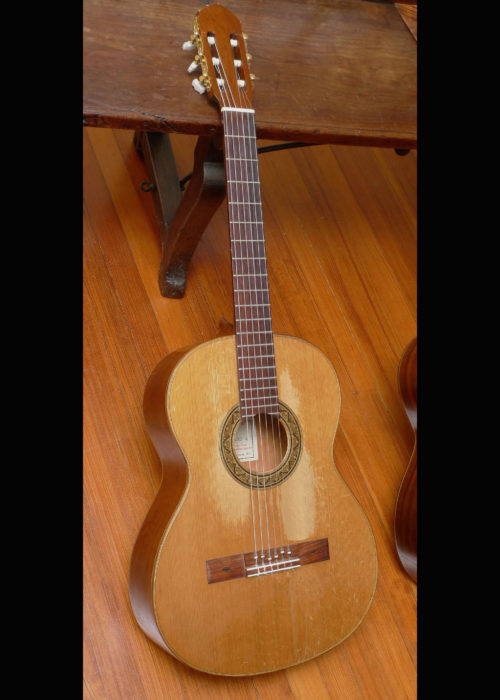
- Cedar top
- Depth at lower bout: 4 3/16 inches
- Width of neck at nut: 2 inches
- Body length: 19 3/4
-
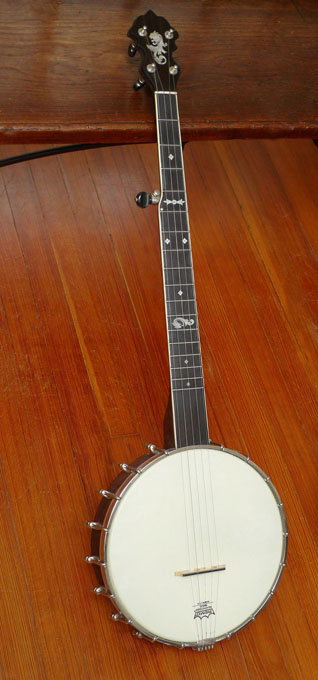 This is a one-of-a-kind custom banjo, from one of the country’s most respected luthiers, based in Appomattox, Virginia. I love this banjo for picking on the couch– it won’t put your back out, picking it up and putting it down, or crush your cat or your sweetheart. It’s lightweight, and with a custom-size head. But it packs beautiful full tone, not the tinny nasal sound from most open back banjos. It’s five or so years old, but with very little wear.
This is a one-of-a-kind custom banjo, from one of the country’s most respected luthiers, based in Appomattox, Virginia. I love this banjo for picking on the couch– it won’t put your back out, picking it up and putting it down, or crush your cat or your sweetheart. It’s lightweight, and with a custom-size head. But it packs beautiful full tone, not the tinny nasal sound from most open back banjos. It’s five or so years old, but with very little wear.- Dark stained maple rim, and neck
- 11 inch pot
- Ebony fretboard
- Engraved dragon inlay in peghead
- Custom MOP inlays
- Bound neck
- No Knot tail piece (Pat. Nov. 19 1901)
- 18 lug
- Brass hoop tone ring
- Dowell stick construction
- nut width 1-¼ inch
- scale: 25- ½ inches
- maple rim diameter: 10- ½ outside
- maple rim thickness: 7/16 inches
- Dark stained maple rim, and neck
- 11 inch pot
- Ebony fretboard
- Engraved dragon inlay in peghead
- Custom MOP inlays
- Bound neck
- No Knot tail piece (Pat. Nov. 19 1901)
- 18 lug
- Brass hoop tone ring
- Dowell stick construction
- nut width 1-¼ inch
- scale: 25-½ inches
- maple rim diameter: 10- ½ outside
- maple rim thickness: 7/16 inches
- With original case.
-
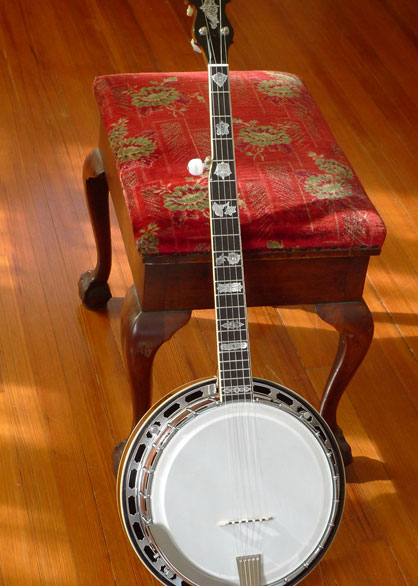 Late 1970s, but in almost unplayed condition. Bluegrass banjo players seek out these 70’s Whyte Eagles, known for their tone and craftsmanship. It was a pretty short window of only about five years, when these banjos were made with this kind of craftsmanship. They blow away most any banjo made and marketed (from any country) in the 60s, 70s and 80s– and they show no logos on headstock– just beautiful mother of pearl. It’s the No. 4310 “Whyte Eagle”. Based on late 1920’s Vega Griffin (Tubaphone #9) style inlays, with engraved, carved heel. Sunburst finish maple banjo, Gibson-style 2 piece flange, full height 20 hole archtop tone ring, dual coordinator rods, flamed maple resonator, maple neck, chrome finish. Neck is butterfly with ebony strip on back of neck, down the center. Just set up, with new tailpiece, and new head, by Dave Trexle and ready to play: loud, clear, and bright. With original hard shell case.
Late 1970s, but in almost unplayed condition. Bluegrass banjo players seek out these 70’s Whyte Eagles, known for their tone and craftsmanship. It was a pretty short window of only about five years, when these banjos were made with this kind of craftsmanship. They blow away most any banjo made and marketed (from any country) in the 60s, 70s and 80s– and they show no logos on headstock– just beautiful mother of pearl. It’s the No. 4310 “Whyte Eagle”. Based on late 1920’s Vega Griffin (Tubaphone #9) style inlays, with engraved, carved heel. Sunburst finish maple banjo, Gibson-style 2 piece flange, full height 20 hole archtop tone ring, dual coordinator rods, flamed maple resonator, maple neck, chrome finish. Neck is butterfly with ebony strip on back of neck, down the center. Just set up, with new tailpiece, and new head, by Dave Trexle and ready to play: loud, clear, and bright. With original hard shell case. -
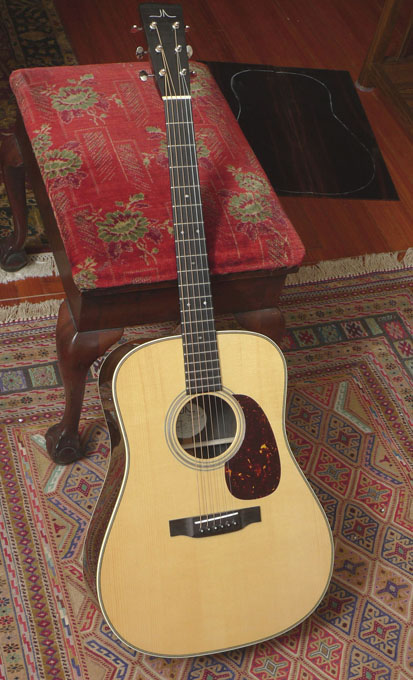 This is a new Allison Brazilian Rosewood dreadnought. Austin-based John Allison was a key part of the Collings Guitar team for years. John is now one of the most sought-after independent makers of fine instruments in the southwest. His guitars are carried by a number of top dealers in the U.S… and we’ve just snagged this brand new, wonderful Brazilian– a custom order guitar. Allison’s attention to detail is astounding. You just have to see and play this great brazilian. Right off the bench, it’s loud and beguiling, and it will only get better over time.
This is a new Allison Brazilian Rosewood dreadnought. Austin-based John Allison was a key part of the Collings Guitar team for years. John is now one of the most sought-after independent makers of fine instruments in the southwest. His guitars are carried by a number of top dealers in the U.S… and we’ve just snagged this brand new, wonderful Brazilian– a custom order guitar. Allison’s attention to detail is astounding. You just have to see and play this great brazilian. Right off the bench, it’s loud and beguiling, and it will only get better over time.- Top: Adirondack Spruce
- Back, and Sides: Brazilian Rosewood
- Bracing: Scalloped X, Adirondack
- Neck: Mahogany
- Finish: Nitrocellulose lacquer
- Herringbone purfling
- Ivoroid binding
- Fretboard: Ebony
- Bridge: Ebony
- Peghead veneer: Ebony
- Scale Length: 25.5 inches
- Nut Width: 1 11/16 inches
- Tuners: Waverly
-
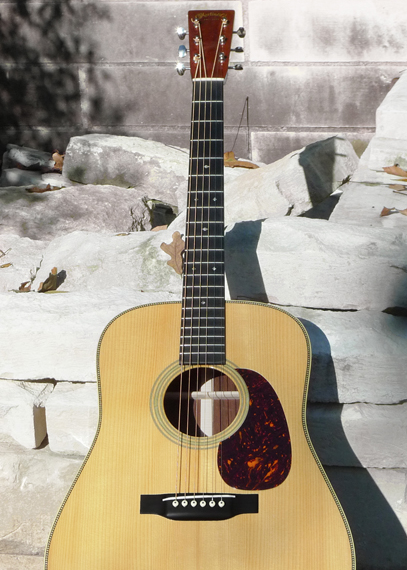 Martin has refined their “Authentic” series 1930’s recreations. When the first D-28A came out a about 5 years ago, it was Brazilian rosewood, with a price tag north of $20K. So when Martin decided to produce a Madagascar rosewood version, it was very welcome. In fact Martin learned from the earlier “Authentic” models and this guitar, one of the very first D-28 Authentics’s made with Madagascar rosewood, is a best of the breed– a recreation of the original 1937 D-28 model but now offered with Madagascar rosewood back and sides. And this instrument has a particularly good set of Madagascar.
Martin has refined their “Authentic” series 1930’s recreations. When the first D-28A came out a about 5 years ago, it was Brazilian rosewood, with a price tag north of $20K. So when Martin decided to produce a Madagascar rosewood version, it was very welcome. In fact Martin learned from the earlier “Authentic” models and this guitar, one of the very first D-28 Authentics’s made with Madagascar rosewood, is a best of the breed– a recreation of the original 1937 D-28 model but now offered with Madagascar rosewood back and sides. And this instrument has a particularly good set of Madagascar.- It’s in virtually unplayed, mint condition.
- Forward shifted hand-scalloped X-bracing
- Fingerboard Width At Nut: 1 3/4''
- Mahogany Blocks/Dovetail Neck Joint - Hide Glue
- Top: Solid Adirondack Spruce
- Top Braces: Solid Adirondack Spruce 5/16''
- Back Material: Solid Madagascar Rosewood
- Back Purfling: 28 Style Zig-Zag (Authentic)
- Side Material: Solid Madagascar Rosewood
- Neck Shape: Authentic 1937 Barrel & Heel
- Scale Length: 25.4''
- Bridge String Spacing: 2-5/16''
- Saddle: 16'' Radius/Long Bone
-
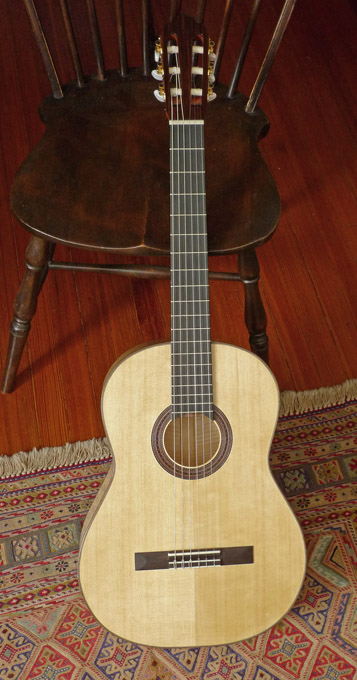 Joseph Redman, based in Abingdon, VA, makes some nice, hand made, yet affordable classical and flamenco guitars. Their low price tags don’t reflect the quality of materials in each instrument. This was a custom order, featuring European Maple back and sides, and all hand French polished by Redman. Nice, rumbling bass response. The Maple tone here, doesn’t show up in the trebles as much as it does in the bass– adding a Maple crispness to the bass strings.
Joseph Redman, based in Abingdon, VA, makes some nice, hand made, yet affordable classical and flamenco guitars. Their low price tags don’t reflect the quality of materials in each instrument. This was a custom order, featuring European Maple back and sides, and all hand French polished by Redman. Nice, rumbling bass response. The Maple tone here, doesn’t show up in the trebles as much as it does in the bass– adding a Maple crispness to the bass strings.- Finish: hand-rubbed French Polish
- 650mm Scale length
- European Maple back and sides
- Canadian Spruce top
- Ebony fretboard
- Neck: Spanish Cedar
- Bindings:
-
 Very few modern luthiers have captured that Larson Brothers sustain and what I call “shimmer” with a new build. This guitar, built by the master luthier Hans Brentrup in late 2009, has it in spades. We’ve never played anything but a 30’s Larson Bros’ that has the sustain this guitar has. Hans’ unique tone bars do what only the Larson tone bar system did– get the body of the guitar to sustain and impart that wonderful shimmer to the trebles especially.
Very few modern luthiers have captured that Larson Brothers sustain and what I call “shimmer” with a new build. This guitar, built by the master luthier Hans Brentrup in late 2009, has it in spades. We’ve never played anything but a 30’s Larson Bros’ that has the sustain this guitar has. Hans’ unique tone bars do what only the Larson tone bar system did– get the body of the guitar to sustain and impart that wonderful shimmer to the trebles especially.- Brazilian Rosewood back and sides
- Engelmann spruce top
- 000 size
- 25.34 scale length
- Easily accommodates Medium or Heavy strings
- Hybrid ladder laminated bracing with Carbon fiber “Tone tubes”
- Mahogany neck
- Slotted headstock
- Golden Age tuners
- Ebony fingerboard with MOP dots
- Pyramid bridge
- Tortoise body binding
- Lacquer finish
-
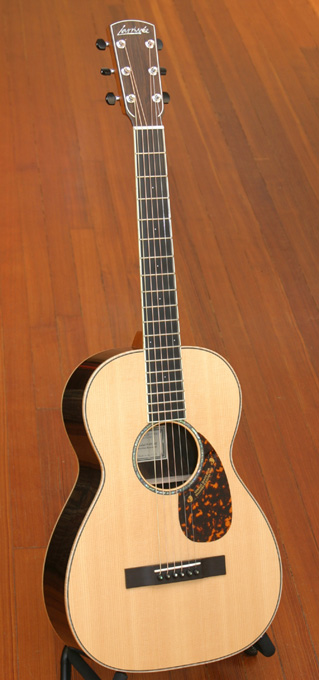 Mint condition. Period. Exceptional Larrivee 12-fret parlor guitar with a straight grained Sitka Spruce top and beautifully figured Brazilian Rosewood back & sides. Part of a very limited run of guitars built of high grade old stock Brazilian rosewood. Abalone rosette and tortoise shell pickguard. Ebony bridge w/ compensated saddle. Mahogany neck w/ microdot inlays, ivoroid bound ebony fingerboard, 1-3/4" nut, 24-1/4" scale, 13-1/4" lower bout, Larrivee logo peghead inlay, chrome tuners w/ebony buttons.
Mint condition. Period. Exceptional Larrivee 12-fret parlor guitar with a straight grained Sitka Spruce top and beautifully figured Brazilian Rosewood back & sides. Part of a very limited run of guitars built of high grade old stock Brazilian rosewood. Abalone rosette and tortoise shell pickguard. Ebony bridge w/ compensated saddle. Mahogany neck w/ microdot inlays, ivoroid bound ebony fingerboard, 1-3/4" nut, 24-1/4" scale, 13-1/4" lower bout, Larrivee logo peghead inlay, chrome tuners w/ebony buttons. -
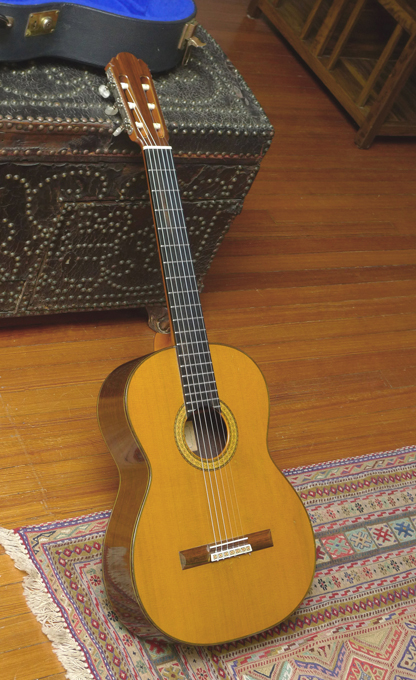 Another fine Kohno classical guitar from Masaru Kohno. This one combines a cedar top with Indian rosewood back and sides for a warm, clear tone. The best sounding Kohno 15 (or 20 for that matter) we’ve had.
Another fine Kohno classical guitar from Masaru Kohno. This one combines a cedar top with Indian rosewood back and sides for a warm, clear tone. The best sounding Kohno 15 (or 20 for that matter) we’ve had.- Cedar Top
- Indian Rosewood Back and sides
- Ebony Fretboard
- Deluxe Fustero tuners, with pearloid buttons
- Scale length: 660mm
- Nut: 52mm
- Condition is good. Several repaired cracks, all well-repaired:
- treble side, about 1/4 inch off fretboard: 3 2/3 inch
- bass side, 1 1/4 inch off fretboard: 4 ¼ inch
- 1/4 inch bass side of center seam, between bridge and soundhole: 4 inches
-
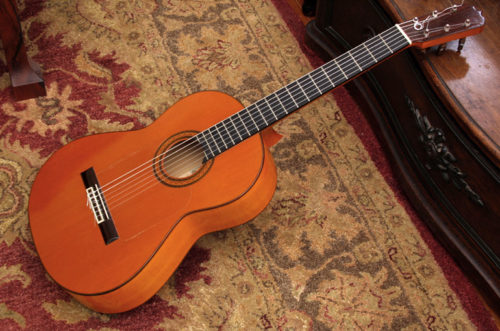 Martin established the X-brace as the standard in American guitars, but that was never pre-ordained, or set in stone. The fan-bracing of the Spanish guitar has equally appealing qualities, and is a century-plus long standard that continues to dominate the design of the classical and flamenco guitar. Not an “Estudio” (student) model, this is the top of line model, 1a Ramirez flamenco. If you’ve never played one of these exquisite cypress Ramirez flamenco guitars–you’ll be surprised at the tone. Spanish cypress back and sides. Cedar top. First of all, the guitar is so light. It floats in your hands, yet it’s tight as a drum. It’s one of the lightest guitars you will ever play (due to the lightness of the wood, and also to the use of tuning pegs–so that the head and neck of the guitar are not pulled down by gravity, allowing the head to float effortlessly at about eye level. And the raspy bass is unbelievable. It’s all about that percussive tone and throaty bass. Conventional wisdom says rosewood for a “classical” guitar, for sustain; and cypress for a flamenco guitar, for the percussive, throaty quality, and more volume. Action is low, as it should be for flamenco. And that wonderful wide nut (2-1/8 inch), you’ve got so much room to move on this beautiful ebony fingerboard. Original finish. As with almost all these old Ramirez flamencos with the tap plate on top, there are shallow, thin hairline cracks where the top edge, and bottom edge, of the tap plate (clear plastic) meets the top (similar to the small cracks you get on an old martin, due to the guard being glued to the top). There is also a six-inch long hairline finish crack on the top above and parallel to the fingerboard (does not go through the wood), and a 3-inch long hairline finish crack below the fingerboard. A few dings here and there, but finish is that original, beautiful high polish reddish-amber.
Martin established the X-brace as the standard in American guitars, but that was never pre-ordained, or set in stone. The fan-bracing of the Spanish guitar has equally appealing qualities, and is a century-plus long standard that continues to dominate the design of the classical and flamenco guitar. Not an “Estudio” (student) model, this is the top of line model, 1a Ramirez flamenco. If you’ve never played one of these exquisite cypress Ramirez flamenco guitars–you’ll be surprised at the tone. Spanish cypress back and sides. Cedar top. First of all, the guitar is so light. It floats in your hands, yet it’s tight as a drum. It’s one of the lightest guitars you will ever play (due to the lightness of the wood, and also to the use of tuning pegs–so that the head and neck of the guitar are not pulled down by gravity, allowing the head to float effortlessly at about eye level. And the raspy bass is unbelievable. It’s all about that percussive tone and throaty bass. Conventional wisdom says rosewood for a “classical” guitar, for sustain; and cypress for a flamenco guitar, for the percussive, throaty quality, and more volume. Action is low, as it should be for flamenco. And that wonderful wide nut (2-1/8 inch), you’ve got so much room to move on this beautiful ebony fingerboard. Original finish. As with almost all these old Ramirez flamencos with the tap plate on top, there are shallow, thin hairline cracks where the top edge, and bottom edge, of the tap plate (clear plastic) meets the top (similar to the small cracks you get on an old martin, due to the guard being glued to the top). There is also a six-inch long hairline finish crack on the top above and parallel to the fingerboard (does not go through the wood), and a 3-inch long hairline finish crack below the fingerboard. A few dings here and there, but finish is that original, beautiful high polish reddish-amber. -
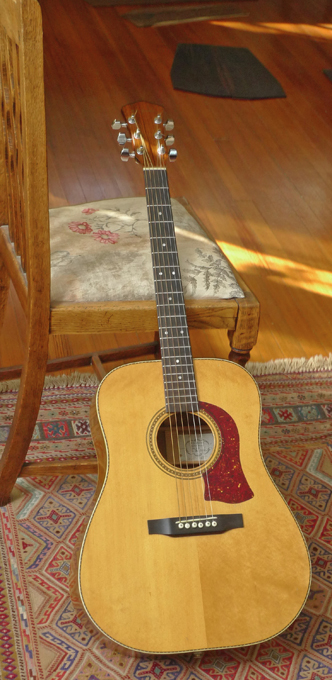 Stuart Mossman was one the country’s top luthiers in the 1970s and 80s– working in the tradition of the great American Dreadnought. According to an article in Vintage Guitar magazine: Stuart Mossman “…. began making guitars in 1965 and through his early efforts concentrated on experimenting with bracing of the tops. He spent four years building 40 or 50 prototypes in his garage at home. By the end of the decade, sensing a niche in the market for high quality handmade acoustics, he had incorporated S. L. Mossman Guitars in Winfield, Kansas and moved into facilities at Strother's Field outside of town. Mossman had noticed what was happening with major acoustic guitar manufacturers at the time. The folk music boom had pushed demand for acoustic instruments to an all-time high and while Gibson, Martin and Guild were increasing production, imports from the Pacific rim countries were beginning to exploit the lower end of the market. Mossman was concerned with what he saw as an erosion in materials, design, and craftsmanship in the construction of the traditional flattop acoustic guitar, particularly among the larger manufacturers as they rushed to meet the strong demand. Using only top-quality woods, a proprietary bracing structure, and old-world building techniques, Mossman guitars entered series production in 1970. ‘We were the first of the small manufacturers to make it as a larger company', Stuart Mossman recalls…” The original 70’s Mossman dreadnoughts are very well built, with attention to detail, and craftsmanship unsurpassed in this period. One of the hallmarks of the Mossman guitar is that each instruments has a paper label inside, with the serial number (that included the year date) and model. And the label was always signed or initialed by the craftsmen building that guitar (this one includes Stu Mossman’s initials: SLM). The Flint Hills model featured East Indian Rosewood back and sides, spruce top, ebony fretboard and bridge, and a unique inlay around the soundhole. This example is all original, and is in fine condition, with no cracks. Original West German Schaler tuners. It has an under-saddle pickup installed, and an input jack in the end pin. Tone is fine, and loud, reminiscent of a 60’s Martin– but with a little more punch in the mids and trebles– a perfect bluegrass instrument.
Stuart Mossman was one the country’s top luthiers in the 1970s and 80s– working in the tradition of the great American Dreadnought. According to an article in Vintage Guitar magazine: Stuart Mossman “…. began making guitars in 1965 and through his early efforts concentrated on experimenting with bracing of the tops. He spent four years building 40 or 50 prototypes in his garage at home. By the end of the decade, sensing a niche in the market for high quality handmade acoustics, he had incorporated S. L. Mossman Guitars in Winfield, Kansas and moved into facilities at Strother's Field outside of town. Mossman had noticed what was happening with major acoustic guitar manufacturers at the time. The folk music boom had pushed demand for acoustic instruments to an all-time high and while Gibson, Martin and Guild were increasing production, imports from the Pacific rim countries were beginning to exploit the lower end of the market. Mossman was concerned with what he saw as an erosion in materials, design, and craftsmanship in the construction of the traditional flattop acoustic guitar, particularly among the larger manufacturers as they rushed to meet the strong demand. Using only top-quality woods, a proprietary bracing structure, and old-world building techniques, Mossman guitars entered series production in 1970. ‘We were the first of the small manufacturers to make it as a larger company', Stuart Mossman recalls…” The original 70’s Mossman dreadnoughts are very well built, with attention to detail, and craftsmanship unsurpassed in this period. One of the hallmarks of the Mossman guitar is that each instruments has a paper label inside, with the serial number (that included the year date) and model. And the label was always signed or initialed by the craftsmen building that guitar (this one includes Stu Mossman’s initials: SLM). The Flint Hills model featured East Indian Rosewood back and sides, spruce top, ebony fretboard and bridge, and a unique inlay around the soundhole. This example is all original, and is in fine condition, with no cracks. Original West German Schaler tuners. It has an under-saddle pickup installed, and an input jack in the end pin. Tone is fine, and loud, reminiscent of a 60’s Martin– but with a little more punch in the mids and trebles– a perfect bluegrass instrument. -
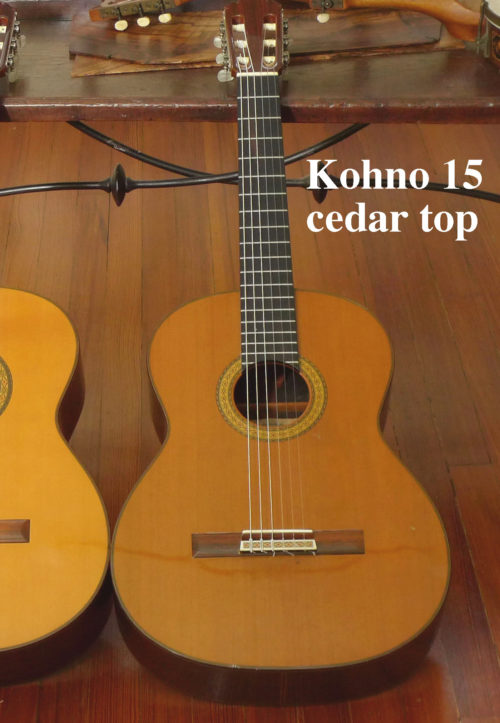 Kohno Classical Guitar. 1976 This instrument is being sold for a customer in Houston with a large collection of guitars. This guitar was originally purchased from VintageAmericanGuitar some five years ago– and its tone has aged and improved. The original Kohno design was specifically different from the high-end Spanish "concert" guitars of the day which had high action and beefy necks (and often long 664 or longer scale lengths). The Kohno necks were moderately thin in profile and shaped for very fluid playability. They’re a joy to play, physically. The 660 scale length– not overly long to begin with– actually “feels” shorter because of the neck design. (And the string spacing at the 2-inch nut: 1 11/16 inches, is also a great feature that adds to the great left hand feel.) We’ve seen/played many Kohnos– this one is unique in the combination of woods, and tone. Cedar top (not spruce), and Indian Rosewood back and sides. The combination, and this guitar’s age and unique voicing produce a dark, bass-rich tone and super clear and strong mids rarely found in a Kohno. It’s louder, darker and deeper than other Kohnos, yet is has great string separation– and the high E string is bell-like and loud.
Kohno Classical Guitar. 1976 This instrument is being sold for a customer in Houston with a large collection of guitars. This guitar was originally purchased from VintageAmericanGuitar some five years ago– and its tone has aged and improved. The original Kohno design was specifically different from the high-end Spanish "concert" guitars of the day which had high action and beefy necks (and often long 664 or longer scale lengths). The Kohno necks were moderately thin in profile and shaped for very fluid playability. They’re a joy to play, physically. The 660 scale length– not overly long to begin with– actually “feels” shorter because of the neck design. (And the string spacing at the 2-inch nut: 1 11/16 inches, is also a great feature that adds to the great left hand feel.) We’ve seen/played many Kohnos– this one is unique in the combination of woods, and tone. Cedar top (not spruce), and Indian Rosewood back and sides. The combination, and this guitar’s age and unique voicing produce a dark, bass-rich tone and super clear and strong mids rarely found in a Kohno. It’s louder, darker and deeper than other Kohnos, yet is has great string separation– and the high E string is bell-like and loud.- Solid Cedar top
- Solid Indian rosewood back and sides.
- Mahogany neck with 2 ebony strips
- Ebony fretboard
- 19 frets
- Rosewood bridge
- Gold engraved Fostero tuners. Fustero tuners are individually made by hand in Spain from the best materials…for decades they have adorned high end instruments built by Fleta, Ramirez, Kohno, Contreras, Bernabe and others.
- 660mm scale length
- 2" nut width
- String spacing at the nut: 1 11/16 inch
- Condition: One, repaired cracks:4 1/2 inches long, about 2 inches to the north (bass side) of the fretboard extension over the body.
-
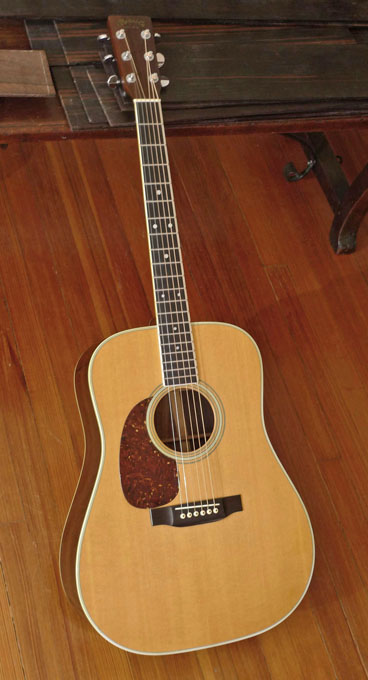 This is a wonderful, original from the factory "Lefty", a 1975 D-35L. Lefty's from this period are rare. Before the era of computerized factories, and the intro of the CNC machines at Martin, a high-end Lefty like this one was essentially a custom-made guitar. The bracing in this guitar was custom designed and built at the Martin factory for a true lefty top– this is not a regular D-35 with just different saddle and pickguard. It's built as a left-handed guitar, down to every brace. This guitar is in about as close to mint condition as you can get. The original black pickguard was lifting a bit (not from wear, there wasn't any– but just because Martin used some odd pickguard material in those years), so we just thought it would be cool to replace it with a vintage 30s style tortoise guard. I had John Allison cut a new guard, using period correct (1930's that is) nitrocellulose material. It looks great. (and BTW it's on the exact footprint of the original guard– they nudged them up a bit closer to the bridge on lefty's). This guitar sounds great. Fine, ringing trebles. Beautiful mids. It's one of the best D-35's we've played, from any period. And again, the condition is just almost mint. No cracks. No checking of finish. Everything except the pickguard is 100% original. It comes in its original hard shell Martin case, and original Martin literature from the Factory. The neck is straight, and action is perfect.
This is a wonderful, original from the factory "Lefty", a 1975 D-35L. Lefty's from this period are rare. Before the era of computerized factories, and the intro of the CNC machines at Martin, a high-end Lefty like this one was essentially a custom-made guitar. The bracing in this guitar was custom designed and built at the Martin factory for a true lefty top– this is not a regular D-35 with just different saddle and pickguard. It's built as a left-handed guitar, down to every brace. This guitar is in about as close to mint condition as you can get. The original black pickguard was lifting a bit (not from wear, there wasn't any– but just because Martin used some odd pickguard material in those years), so we just thought it would be cool to replace it with a vintage 30s style tortoise guard. I had John Allison cut a new guard, using period correct (1930's that is) nitrocellulose material. It looks great. (and BTW it's on the exact footprint of the original guard– they nudged them up a bit closer to the bridge on lefty's). This guitar sounds great. Fine, ringing trebles. Beautiful mids. It's one of the best D-35's we've played, from any period. And again, the condition is just almost mint. No cracks. No checking of finish. Everything except the pickguard is 100% original. It comes in its original hard shell Martin case, and original Martin literature from the Factory. The neck is straight, and action is perfect. -
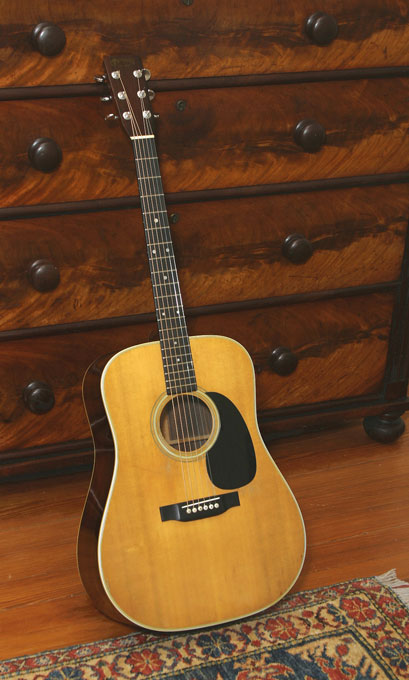 The last of the Mohicans, made within a few months before Martin stopped using Brazilian Rosewood on its instruments. Some guitars feel dead right the minute you pick them up. This is on of those. First and foremost, the tone of this instrument is unsurpassed for the bell-like trebles that only come from Brazilian Rosewood. The tone of this guitar, I would hold up to most mid-40’s D-28’s I’ve played. Playability, and set-up: it could not be better, and it’s got that 60’s combination of low action, great tuning speed and accuracy from the Grovers, and superb intonation all the way to the wee frets. More than anything, this guitar stands out for its low action combined with robust tone. Amazingly, the string height at the 12th fret: Just a hair over 2/32” at the high E; and 3/32 at the low E. It plays in our left hand like a dream, fast and fluid… yet the tone is full with no buzzing anywhere. I personally have never played a Martin dreadnought from any period that is so effortless to play, so easy on the left hand and so fast and yet so full of Brazilian tone. BTW, light gauge strings only? No way… I’ve got it strung with medium gauge, and it plays like butter in your left hand. Condition:
The last of the Mohicans, made within a few months before Martin stopped using Brazilian Rosewood on its instruments. Some guitars feel dead right the minute you pick them up. This is on of those. First and foremost, the tone of this instrument is unsurpassed for the bell-like trebles that only come from Brazilian Rosewood. The tone of this guitar, I would hold up to most mid-40’s D-28’s I’ve played. Playability, and set-up: it could not be better, and it’s got that 60’s combination of low action, great tuning speed and accuracy from the Grovers, and superb intonation all the way to the wee frets. More than anything, this guitar stands out for its low action combined with robust tone. Amazingly, the string height at the 12th fret: Just a hair over 2/32” at the high E; and 3/32 at the low E. It plays in our left hand like a dream, fast and fluid… yet the tone is full with no buzzing anywhere. I personally have never played a Martin dreadnought from any period that is so effortless to play, so easy on the left hand and so fast and yet so full of Brazilian tone. BTW, light gauge strings only? No way… I’ve got it strung with medium gauge, and it plays like butter in your left hand. Condition:- all original: finish; frets bridge, bridge plate, saddle. (Bridge pins could be replacements, hard to tell, but they are right.)
- The bridge looks like it has never been off
- Neck has never been set
- There is minor pickwear, with some moderate wear around the soundhole.
- No cracks on top; two, almost indiscernible cracks on back, that have been addressed–glued (no cleats). You have to look very hard to see these two back cracks, they are hairline cracks, each about 6 inches long.. but they are not visible from more than a few inches away, and impossible to photograph.
- Minor nicks and dings, most are visible in photos
- No strap lugs ever added
- Original end pin
- Throw away the book on this one… This is one of the best Brazilian rosewood Dreadnought Martins you’ll play, period, in fine original condition.